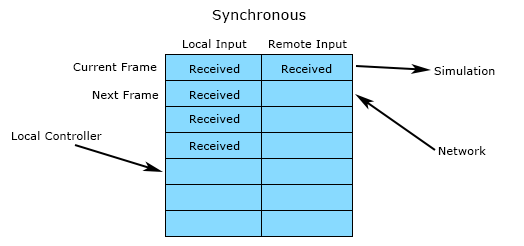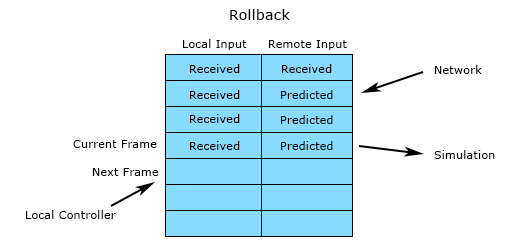INVERSUS is a fast-paced shared-screen multiplayer game for up to four players. It is the type of game that would traditionally be local-multiplayer, and for a long time I thought latency issues would make it a poor candidate for online. Late in development, I committed to adding online support with the mindset that a “playable but inferior” experience would be better than nothing, but I ended up with something hard to differentiate from its local counterpart! While the subject of networking can cover everything from matchmaking, to choosing a map, and finally playing the game, I’m only going to be discussing the gameplay portion. I want to break down how I made the split-second actions of INVERSUS into a polished online experience.
Overview
INVERSUS uses a peer-to-peer rollback system. Before getting into the implementation details, let’s review how rollback networking functions at a high-level.
Rollback networking an evolution of synchronous networking systems where every player would send input commands to every other player. In these systems, a deterministic game simulation would advance one frame every time it had received commands from each peer. This architecture had numerous benefits, but one huge caveat that drove action games away from it: input latency. In order to allow time for receiving remote player input, the local input wouldn’t be injected into the simulation for a number of frames equal to the transfer speed.

Rollback fixes the latency issue by processing local inputs immediately while predicting the remote inputs. When the actual remote inputs arrive over the network, it checks if anything was mispredicted. If a misprediction was found, time will be rewound to the mispredicted frame and then simulated back to the present using the corrected input values and further predicted values. This rollback and correction process all happens in the span of a single frame such that user only sees a slight pop in the results.
As network latency increases, visual pops in motion will increase, but they will only be in relation to direct effects of remote player input. For example, the launching of a projectile might skip the first couple frames, but once the projectile is in flight it can be reacted to exactly as if it were in a local multiplayer game.
Rollback networking is designed to create a near zero latency experience for the local user and fair conflict resolution because every participant’s inputs are respected. When you move, you move right away. If you press a button on a specific frame to counter an attack, you will counter the attack. This architecture also creates a minimal overlap in which game and network code need to consider one another. When adding features to the game, there is almost zero concern about networking. Everything just works and that’s a rather freeing experience for the engineer.
The main downsides of rollback are that it does not easily support joining in-progress matches, and it does not scale to large player counts. It also doesn’t support a variable frame rate simulation, but I’ll discuss how it can still support variable frame rate rendering later.
Rollback is perfect for fast, twitchy, frame-accurate games that require responsive input and have short gameplay rounds. It is the standard approach for modern fighting games and should be the standard approach for any quick round-based game with direct player interaction.
Preparing the Simulation
For any of this to work, your game code needs to support a deterministic simulation and the ability to quickly store and restore the simulation state. You might even already support these features for other reasons. If not, adding support opens up so many useful debug and replay features that it’s honestly worth it regardless of the networking model.
Determinism
In order to have a deterministic simulation, player input should be the only external influence of how the game will resolve. Given a set of initialization parameters (e.g. level name, time step and a random seed), I can recreate the entire playthrough of a game given just the stream of input commands (button presses, joystick positions). This isn't actually that difficult to maintain, as long as you follow some general guidelines and architect your game such that gameplay logic isn’t reaching out into global systems. For anyone that hasn’t thought about determinism, I want to give some examples of things to avoid:
Don’t check any sort of real world time values (local or networked).
Only compute durations using the simulation time step value.
Only generate new random seeds based simulation state or initialization parameters.
Avoid polling information from global systems which may not have had determinism in mind
The more functional you can keep your simulation the safer it will be.
Supply external information (e.g. input state) to you update rather than having the game code ask for things. This will make it easier to track what external factors need to be synchronized for a deterministic playback.
Don’t let dynamic memory addresses affect logic.
If you are iterating over a container:
Don’t sort it by memory pointer values unless the pointer order is deterministic.
Don’t sort it by hashes of memory pointer values unless the absolute pointer address is deterministic (unlikely).
Don’t let uninitialized memory impact logic.
If you are iterating over a container:
Don’t sort it by direct memory comparison of structures which might have uninitialized padding. For example in C/C++, using a constructor or bracket based initialization will not clear padding between member variables. You need to memset() to clear all data.
Don’t sort it by hashes of structures which might have uninitialized padding.
Don’t check any sort of local system information:
Avoid absolute file paths
Avoid local account ids and usernames
Don’t run different logic based on machine architecture (e.g. optimized math routines)
Be careful how you merge data that was computed on parallel threads (need a canonical order)
If you need to support determinism across multiple compile targets, make sure the optimizer will respect your floating-point math.



































